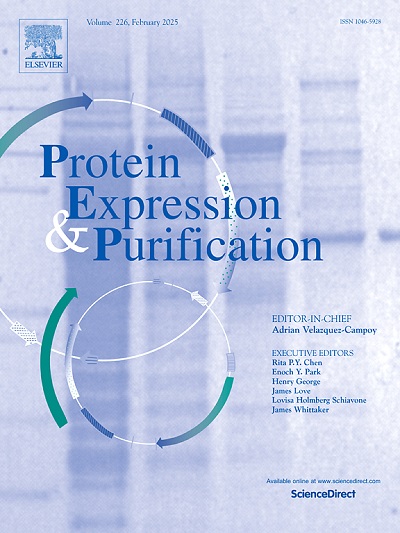在大肠杆菌中增强功能性CRISPR-AsCas12a蛋白的产生
IF 1.2
4区 生物学
Q4 BIOCHEMICAL RESEARCH METHODS
引用次数: 0
摘要
CRISPR-Cas12a系统是一种开创性的工具,广泛用于生物技术和生物医学研究实验室的基因组编辑和诊断。尽管其应用越来越广泛,但在实验室规模上使用直接协议优化Cas12a蛋白生产的研究仍然很少。本研究旨在提高酸胺球菌Cas12a蛋白(AsCas12a)在大肠杆菌中的实验室规模重组生产。通过简单参数的针对性调整,AsCas12a产量显著提高。优化条件为大肠杆菌BL21(DE3), TB培养基中添加1%葡萄糖,0.3 mM IPTG诱导至少6-9 h, 30℃孵育。值得注意的是,这些条件不同于通常用于Cas12a和相关蛋白(如化脓性链球菌Cas9)的常规方案。综合所有优化的参数后,AsCas12a的产量增加了约3倍,从非优化条件下的0.95 mg/mL细菌裂解物增加到优化条件下的3.73 mg/mL。经层析纯化后,最终的蛋白产量提高了约4.5倍,从5.2到23.4 mg/L的培养体积,而不影响功能活性。纯化后的AsCas12a在体外可编程DNA顺式切割和侧支反式切割中保持了充分的活性,并成功用于检测SARS-CoV-2的N基因。这种优化的方法为全球许多研究实验室提供了一种高效、高产的方法,可以使用可获得的材料和条件来生产功能性AsCas12a蛋白。本文章由计算机程序翻译,如有差异,请以英文原文为准。
Enhanced production of functional CRISPR-AsCas12a protein in Escherichia coli
The CRISPR-Cas12a system is a groundbreaking tool widely used for genome editing and diagnostics in biotechnology and biomedicine research laboratories. Despite its growing application, studies optimizing Cas12a protein production at the laboratory scale using straightforward protocols remains scarce. This study aimed to enhance the lab-scale recombinant production of Acidaminococcus sp Cas12a protein (AsCas12a) in E. coli. Through targeted adjustments of simple parameters, AsCas12a production was significantly increased. The optimized conditions included the use of E. coli BL21(DE3), TB medium supplemented with 1 % glucose, induction with 0.3 mM IPTG for at least 6–9 h, and incubation at 30 °C. Notably, these conditions differ from conventional protocols typically used for Cas12a and related proteins, such as Streptococcus pyogenes Cas9. Upon combining all optimized parameters, AsCas12a production increased approximately 3-fold, from 0.95 mg/mL of bacterial lysate under non-optimized conditions to 3.73 mg/mL under optimized ones. After chromatographic purification, the final protein yield rose approximately 4.5-fold, from 5.2 to 23.4 mg/L of culture volume, without compromising functional activity. The purified AsCas12a retained full activity for programmable in vitro DNA cis-cleavage and collateral trans-cleavage, which was successfully applied to detect the N gene of SARS-CoV-2. This optimized method provide an efficient and high-yield approach for producing functional AsCas12a protein using accessible materials and conditions available to many research laboratories worldwide.
求助全文
通过发布文献求助,成功后即可免费获取论文全文。
去求助
来源期刊

Protein expression and purification
生物-生化研究方法
CiteScore
3.70
自引率
6.20%
发文量
120
审稿时长
32 days
期刊介绍:
Protein Expression and Purification is an international journal providing a forum for the dissemination of new information on protein expression, extraction, purification, characterization, and/or applications using conventional biochemical and/or modern molecular biological approaches and methods, which are of broad interest to the field. The journal does not typically publish repetitive examples of protein expression and purification involving standard, well-established, methods. However, exceptions might include studies on important and/or difficult to express and/or purify proteins and/or studies that include extensive protein characterization, which provide new, previously unpublished information.
 求助内容:
求助内容: 应助结果提醒方式:
应助结果提醒方式:


